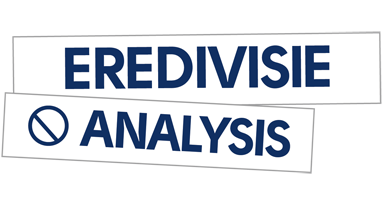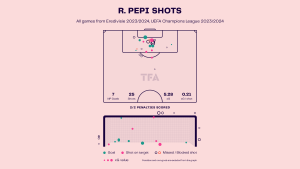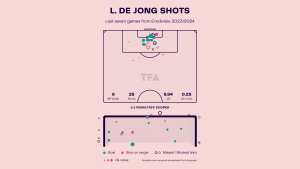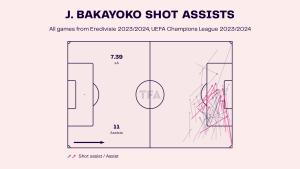Another round goes by and Feyenoord kept its invincibility at the Eredivisie this season. In a well-played match against Groningen, the winning by 2-0 maintains the team close to Ajax in the top of the league.
In this tactical analysis we’ll see how Dick Advocaat, Feyenoord’s manager, choose to explore the vulnerability on Groningen’s defence to secure the win. We’ll check the tactical variations of both teams trying to control the match and how it was executed.
Lineups and formations
Feyenoord started the match in its usual formation, 4-2-3-1. With very little variation, Steve Berghuis was the central player of the team but playing at the right side. The player conducted most of the attacking constructions floating to the middle. Supporting Orkun Kökçü in the middle and approaching Bryan Linssen and Ridgeciano Haps in the attack.
With the absence of former Bayern Munich player Arjen Robben, Groningen’s manager Danny Buijs continues to experiment variations in his team. This particular match the defence was set in a four-line formation but when the team attack, Damil Dankerlui on the right side joined a four-line in the midfield letting a three-way ball exit in the offensive construction.
Groningen’s variations
With 51% of ball possession and more touches and passes than Feyenoord, Groningen’s variation proposed the control of the match. With the ball, the team use the multi-skilled Dankerlui on the right side and Gabriel Gudmundsson on the left to give width amplitude to the team.
The image below shows how the team was positioned when attacking the opponent. The left-back B. Van Hintum hold back in the defence with K. Itakura and W. Dammers. A. Matusiwa covers the defence in the middle with Dankerlui, El Messaoudi, D. Van Kaam and Gudmundsson in a four-line in the middle/attack.
This 3-1-4-2 attacking formation give Groningen’s width amplitude to explore opposite inversions of the ball, especially with the defenders linking to Dankerlui and Gudmundsson. When the ball was long, R. Balk and P. Joosten were always approaching the sides to triangulate with the teammates.
The problem was that with a well-posted defence of Feyenoord, Groningen didn’t have much room to create chances. It was only one shot on target the entire match. The ball hit the woodwork when Balk retrieves it in an offensive pressure on the opponent’s half.
Defensive issues
With the attack stoping in the good defence of Feyenoord, Groningen’s defence failed to hold Berghuis and Haps on the other half.
When defending, Groningen’s Dankerlui and Gudmundsson hold back in the defence line making a 5-3-2 formation. The image below shows the defence mounted to prevent Feyenoord’s infiltration on the sides.
But the slow intensity on the duels and to follow the opponent’s to the end broke the lines and it was trespassed by Feyenoord. Berghuis on the right side created trouble approaching with Köçkü and Linssen. Of the nine shots on goal, six of them was on target. Berghuis gave two and Köçkü another two shots.
The left side was also used to break Groningen’s defence line. With an excellent match of the left-back T. Malacia, Feyenoord found spaces behind the Groningen’s defence. The image below shows the triangulation between Haps, J. Toornstra and Malacia infiltrating the space behind Dankerlui, who lack the intensity to follow the opponent.
In this frame, Feyenoord ended up with a goal scored but invalidated by VAR. Even with less ball possession, the team found ways to enter Groningen’s defence in the same mode. The origin of the second goal of Feyenoord in the right side.
The image below shows João Teixeira giving a vertical pass to Berghuis behind Groningen’s defence. At this time of the match, D. Buijs team was a full attack and it was giving many spaces on the side of the defence. Berghuis advanced on the right and made the cross to Haps on the opposite side suffers the penalty foul.
Feyenoord’s control of the match
Dick Advocaat’s team had control of the match even without the ball possession. It wasn’t super intense but it was right positioned all time. With Mark Diemers and J. Toornstra securing and centralizing the middle possession, the team had 81% of pass accuracy and both players had the most exchanged passes. Diemers had 89% of pass accuracy playing only the half time while Toornstra had 61% of the long ball passes accuracy.
In the second half, Teixeira replaces Diemers and Köçkü was held back in the pitch. That position gave more pass quality in the middle making Feyenoord actions most successful. The heatmaps below of Toornstra and Köçkü shows how they were all places in the middle.
With Feyenoord closing spaces and controlling the middle, it wasn’t hard to prevent Groningen’s attack to reach their final third. In the image below we can see how Teixeira helps close the middle and Groningen has no room to progress.
Conclusion
Feyenoord took advantage of Groningen’s defence vulnerability to secure the win and the use of Berghuis, former Premier League player, on the right side was crucial to the winning plan. The analysis showed how Feyenoord was intense enough to control the middle and fatal to use the counter-attacks.
Groningen’s manager was more creative in the tactics and variations of his team, but the lack of accuracy in the offensive third along with the flaws in the defence set the loss at the end. We can see that the team has been training different movements to execute in the match but after two consecutive wins, it wasn’t enough to hold Feyenoord’s attack.
















